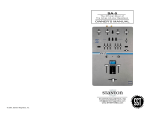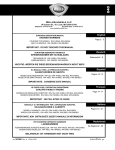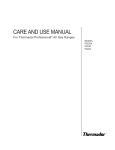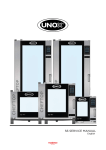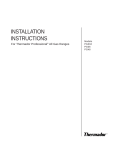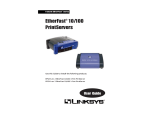Download Stanton M304 DJ Equipment User Manual
Transcript
M.304 PROFESSIONAL DJ MIXER OWNER’S MANUAL STANTON MAGNETICS, INC [email protected] w w w . s t a n t o n d j . c o m WELCOME! Thank you for making Stanton your first choice in professional DJ mixers. This innovative family of mixers has been developed with input from the professional DJ community, bringing a previously unavailable, combination of user-friendly, functional design, rugged construction, and professional quality features together at an affordable price. Stanton and your authorized Stanton dealer are dedicated to your complete satisfaction by offering benchmark service and support throughout the long life of your Stanton product. We appreciate your patronage, and look forward to many years of making music together. P L E A S E R E A D C A R E F U L LY B E F O R E U S E FAILURE TO FOLLOW THE INSTRUCTIONS PRINTED BELOW MAY VOID WARRANTY • Follow all security advice printed on your mixer • When removing the unit's AC plug from the power source, grasp and pull the plug, NEVER the cord itself! • Avoid placing your mixer near heat sources, such as power amplifiers. • When in use, place your mixer on a stable surface, away from vibration. Always use care when carrying your mixer. Impact, or heavy vibration may compromise the unit's mechanical integrity. The manufacturer is not responsible for damage resulting from an impact, or misuse. • When in use, place your mixer away from sources of hum or noise, such as transformers, or electric motors. • To prevent overheating, always provide your mixer with adequate ventilation air space. • Avoid stepping on your mixer's AC cord. Repeated compression of the cord may lead to electrical shorting. • To avoid damage due to AC voltage peaks, always disconnect your mixer from the power source during electrical storms. If possible connect mixer to a surge protector. • Your mixer contains no user-serviceable parts. The manufacturer is not responsible for any damage or personal injury resulting from unauthorized user-servicing or modifications. In addition, the warranty will be void if any unauthorized service by the user is detected. Always return your mixer to an authorized Stanton dealer for servicing. M . 3 0 4 F E AT U R E S When Stanton set out to design its new M.304 3Channel DJ Mixer, compromise was not an option. This 10" professional mixer boasts a wide range of intuitive controls, superb sound, and high-quality components including a genuine Penny & Giles crossfader. Whether mixing house, techno or trance from vinyl or CDs, the M.304 has got all the bases covered, thanks to 3 phono inputs, 6 line inputs and 2 mic inputs with independent EQ. Each channel sports gain control, bright input LED meters, a 3-band EQ with full Kill capability, as well as Pan knobs. The M.304 also sports a full-featured Cue section which includes PFL, Cue Pan, and dual headphone outputs for tag-team mixing. Professional DJs will immediately appreciate the M.304s 3-band Kill switches for channels 1 and 3, conveniently located right next to the crossfader. For creative mixing, the M.304 also offers an Effects loop with 1/4" Send and Return jacks. This mixer is rounded out with professional balanced Master outputs, separate Booth output, and a user-replaceable fader design. DESCRIPTION OF FUNCTIONS DESCRIPTION OF FUNCTIONS 1. Microphone 1 input - This combo (1/4”/XLR) connector is used to connect a microphone. The volume is controlled by the MIC 1 knob. 2. Microphone 2 input - This 1/4” connector is used to connect a microphone. The volume is controlled by the MIC 2 knob. 3. Mic 1 level - Controls the input level of Microphone input 1. 4. Mic 2 level - Controls the input level of Microphone input 2. 5. Mic equalizer - Individual controls for high frequency, midrange, and low frequency equalization. The EQ controls both Microphone inputs. Note: Any changes made to EQ settings will change the overall output level. 6. Effect assign - Used to assign the effect signal to each channel or the mic. The level of the effect is controlled by the Send and Return knobs. 7. Pre fader listen - Selects the channel(s) - 1, 2, or 3 - to be previewed in the headphones. 8. Channel faders - Controls the output volume of each channel. The signal is routed to the line faders after the gain, EQ, pan, and effects. 9. Crossfader - The crossfader is used to cross fade between channels 1 and 3. 10. Kill switches - Kill switches are used to completely eliminate Hi, Mid, or Low frequencies from the audio. This can be used as a performance effect. 11. Headphone outputs - This is the headphone output jack to connect your headphones. 12. Cue pan - Fades the headphone output between the PFL signal (selected by the Cue Select buttons) and master output, effectively allowing the user to preview a mix. 13. Cue level - Controls the volume of the headphone output. 14. Booth level - Controls the booth output level. This is basically a 2nd output. It is usually used for monitoring in a DJ booth, but can be used for various applications. 15/16. Effect Levels - Send and Return levels are used to control the volume of the external effects unit connected to the M.304 using the jacks labeled ‘send’ and ‘return’ on the back of the mixer. SEND is the level of the signal sent to the effect unit, and RETURN is the level of the processed signal returning from the the effects unit. the signal sent to the unit is selected by pushing the ‘FX LOOP’ button. 17. Master output Pan- This is the pan or balance control for the mast output. DESCRIPTION OF FUNCTIONS 18. Master output level - Controls the overall output level of the mixer. 19. Output meters - These LEDs let you know if the audio coming out of the mixer is loud enough (or too loud!). If the LEDs reach the red, the mixer is probably clipping, or distorting. 20. Input selectors - These toggle switches select the input source between phono and line for each channel. 21. Input gains - Controls the input sensitivity level of each channel. An LED meter is provided on each of the 3 channels for proper adjustment of the levels. 22. Channel equalizer - Individual controls for high frequency, midrange, and low frequency equalization with +9dB/Kill adjustments. Note: Any changes made to EQ settings will change the overall output level. 23. Channel pans - Controls left/right output balance of each channel. DESCRIPTION OF FUNCTIONS Power: This is the power switch to turn the mixer "ON" or "OFF" AC IN: This is the Input connection for the included power supply. Send and Return: These connectors are used to connect an outboard signal processor (such as the Stanton DFX-1). Connect a 1/4” mono cable from the SEND output to the Line In on your signal processor. Connect the RETURN input to the Line Out on your signal processor. Your effects loop should now be working. Check it by turning the send and return volume knobs to the center position (12 o’clock) and selecting FX LOOP on any of the mixer’s channels. Line: Line inputs (represented by the letter L, followed by the input number) are used to connect to line level sources such as CD players, Mini Discs, DATs, samplers, etc. TT: TT (or phono) inputs are used to connect to turntables. Ground: Connects to the turntable ground cable to eliminate electrical hum. Ground cables are usually supplied with turntables. Master: Connects to an amplifier, EQ, crossover, or other outboard signal processing. Booth: This is a second output, like the master output. It is usually used as a separate output in the DJ Booth for the DJ to monitor the mix. REC: This is the record output. The output level is static in this case, there are no volume controls. It is used to connect directly to tape or CD recorders. The volume can be set from the recording device. FA D E R C L E A N I N G A N D R E P L A C E M E N T After constant use the M.304 faders may need to be cleaned and lubricated from time to time. This will ensure long life and keep a smooth feeling throughout the fader's lifetime. Follow the instructions below to lubricate and clean your faders: Removing a fader: 1. Make sure mixer is powered off and power supply is disconnected from back of mixer. 3. Remove the fader to be cleaned or replaced by unscrewing the 2 outer screws on the fader plate (removing the 2 inner screws will detach the fader from the fader plate). 4. Disconnect the fader from mixer by removing the connector on the bottom of the fader. Installing a fader: 1. Once original fader has been removed, simply plug the 4-pin connector into the new fader. 3. Place fader back in mixer and replace 2 outer screws to secure fader. Cleaning a Penny & Giles fader: 1. Remove 2 mounting screws from fader plate. (NOTE: The P&G fader is designed with floating mounting threads for precise mechanical centralizing of the fader. If you desire to keep your fader`s current mounting position we suggest that you make 2 marks on both ends of the fader on the fader plate to indicate the P&G fader position.) See Figure 1. 2. Once fader is removed from unit, remove the two screws (A) from the end of the fader body where the wires exit the fader casing. Pull away the end block. Withdraw the dust cover (B). Taking great care, remove the slider assembly (C), ensuring that the wiper contacts (D) are not damaged as this will affect the operation of the fader. Clean the slider assembly by gently wiping the wiper contacts and slider bearings (E) using a tissue or cotton bud. If slider bearing are excessively worn, as indicated by excessive slider rocking then contact Stanton for replacement. 3. Remove the single upper screw on the opposite end block to remove the guide rail. Clean the guide rail (F) with a tissue or cloth, remov- Figure 1 FA D E R C L E A N I N G A N D R E P L A C E M E N T ing all traces of dirt and contamination. 4. Remove the fader track (G) by slowly withdrawing from the unit. Place fader track on desk or working surface with black contacts facing upwards. If necessary, the track can be washed in warm water, wiped gently then dried thoroughly using a dry cloth. Use a lint free cloth or swab to wipe the tracks and check for marks along the track. (Note: Lint free cloth should be used to avoid dust/fibers being deposited on the track). If the track appears excessively worn, or if cleaning does not improve operation, replacement may be necessary. A B F G 5. Examine the center channel of the fader body and if dirty, clean using cotton buds. 6. Re-assemble and lubricate the fader as follows: C 6.1) Secure the end block and guide rail onto the fader body. E 6.2) Insert track into the fader body. D 6.3) Insert slider assembly onto guide rail and into the fader body. Move slider from end to end to disperse the oil evenly. Carefully wipe away any excess oil using a tissue or cloth. 6.4) Lubricate the guide rail by placing one drop of silicon liquid oil onto the guide rail (F). G 6.5) Insert dust cover. 6.6) Insert fader track back into fader body with wires coming out open end of fader body. I 6.7) Secure the remaining end block ensuring that the track wires (I) are not pinched between the end block and fader casing. 7. Once assembled, move the slider from end to end to ensure operation is smooth. 8. Attach fader to fader plate. (NOTE: As noted earlier if you do not want to change positioning of fader, keep the 2 fader plate screws loose and shift the fader until it is aligned with the marks you created in step 1, then tighten fader plate screws.) T E C H N I C A L S P E C I F I C AT I O N S Line Inputs: 2 (RCA) x 3 channels, -10 dBV /10 kOhm Phono Inputs 2 (RCA) x 3 channels, -50 dBV / 47 kOhm Mic Inputs 1(1/4")/ 1 XLR -50 dBV /4.7 kOhm Return Inputs 2 (1/4"), -10 dBV / 10 kOhm Send Outputs 2 (1/4"), -10 dBV Master Outputs 2 (1/4”) Balanced/ (RCA) unbalanced, -2 dBu balanced / -10 dBV unbalanced Record Outputs 2 (1/4”) Balanced/ (RCA) unbalanced, -2 dBu balanced / -10 dBV unbalanced Booth Outputs 2 (1/4”) balanced, -2 dBu / 100 Ohms Headphone Output 1 (1/4 inch), 1 (1/8 inch)greater than 32 Ohm load Dimensions (LxWxD) 15.3 in x 10.2 in x 4.3 in (39 cm x 26 cm x 11 cm) Weight 7.7 lbs (3.5 kg ) Frequency Response 20 Hz to 20 kHz +/-1 dB (line) Max Gain 12 dB THD+N < 0.015 % at 1 kHz Signal to Noise Ratio 110 dB (main signal path) (ref: max level) Noise < -92 dBV (Line input to any output) Channel EQ Hi +9, -45 dB, Kill: -45 dB Mid +9, -35 dB, Kill: -35 dB Low +9, -55 dB, Kill: -55 dB Crosstalk < -90 dB at 1 kHz Fader Kill < -90 dB (channel and crossfader) R E P L A C E M E N T PA R T S The following user replaceable parts are available from your local Stanton dealer. LF304 CF-PG304 PS-16US PS-16EU PS-16UK Channel input fader Penny & Giles crossfader US Power Supply (110v) European Power Supply (220v) UK only Power Supply (240v) WA R R A N T Y Stanton Magnetics, Inc. – Warranty Provision – Returns for Repairs or Replacement Warranty Through Stanton’s authorized dealers around the World, Stanton, or one of Stanton’s authorized distributors outside the U.S., will, without charge, repair or replace, at the sole discretion of the entity responsible for making the repair or providing the replacement, any Stanton merchandise proved defective in material or workmanship for a period of one (1) following the date of original purchase. Exceptions to this warranty are as noted below: The warranty for mechanical parts which are subject to wear and tear are limited to the earlier to occur of thirty (30) days following the date of original purchase or the following number of cycles: Faders - 15,000; Rotary potentiometers - 10,000; and Switches - 10,000. Stanton will warrant all replacement parts and repairs for ninety (90) days from the date of original shipment. Repairs made necessary by reason of misuse, alteration, normal wear, or accident are not covered under this warranty. Returns Authorized Stanton dealers are only authorized to sell and distribute merchandise within a specific country. All goods requiring warranty repair or replacement must be returned (freight prepaid if not hand-delivered) to the authorized Stanton dealer from whom the merchandise was purchased and in the same country where the merchandise was purchased. For purposes of purchases made via the Internet, the merchandise must be returned to the authorized Stanton dealer in the country where the authorized Stanton dealer which sold the merchandise to purchaser is located and not the authorized Stanton dealer in the country where the purchaser is located or the country in which the merchandise was received. Any returns to a non-authorized dealer or to an authorized Stanton dealer not in the same country as the merchandise was intended to be sold or as set forth above will void this warranty. To initiate a warranty repair, you must contact the authorized Stanton dealer from whom you purchased the merchandise, and follow such authorized Stanton dealer’s return policy. Stanton assumes no risk and shall be subject to no liability for damages or loss resulting from the specific use or application made of the merchandise. Stanton's liability for any claim, whether based on breach of contract, negligence, infringement of any rights of any party, or product liability, and relating to the merchandise shall not exceed the price received by Stanton from your purchase of such merchandise. In no event will Stanton be liable for any special, incidental or consequential damages (including loss of use, loss of profit and claims of third parties) however caused, whether by the negligence of Stanton or otherwise. To the extent permitted by law and except as otherwise provided above, Stanton disclaims any express or implied warranties of merchantability or fitness for a particular purpose. The above warranty provides you with specific legal rights. You may also have additional rights, which are subject to variation from state to state and country to country. If there is a dispute regarding the warranty of merchandise that does not fall under the warranty conditions stated above, please include a written explanation with the merchandise when returned pursuant to the terms and conditions set forth herein. Please register your product online at www.stantondj.com or mail your completed warranty card to: Stanton Magnetics, Inc, 3000 SW 42 St. Hollywood, Florida 33312.











